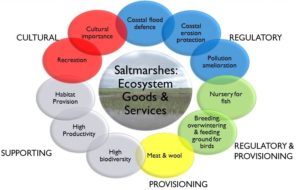Inter-tidal ecosystem health and resilience through salt marsh regeneration
Salt marshes are plants which have adapted to survive the high salinity found in the intertidal zone of estuaries. They are a biologically and economically important ecosystem, performing a number of ecosystem functions which provide both direct and indirect benefits to humans (see image). These benefits are known as ecosystem services. For example the plants attenuate wave energy and act as a natural form of coastal flood defence. Salt marshes have been declining over the past century, primarily as a result of human impacts, principally coastal development and sea level rise. My research aims to improve our understanding of the ecosystem functions that salt marshes perform and the economic worth of the services they provide.
A thirteen month field campaign measuring the biodiversity, community structure and ecosystem functions of natural saltmarsh, mudflat and restored saltmarshes (transplanted 2003 – 2013) has been completed in the Eden estuary, located to the north of St Andrews. Knowledge of the species present and the role they perform within the saltmarsh will help us to understand how they contribute to different ecosystem functions. In addition to an improved understanding of the ecosystem functions for saltmarshes, a development trajectory for how long it takes for restored saltmarshes to resemble natural saltmarshes can be estimated for the different functions.
One of the most important ecosystem services provided by salt marshes is coastal flood defence. Placing an economic value on this is challenging as there are a number of alternate options available. I am currently designing an experiment examining what locals preferences are for the location of, extent of and type of coastal defences in the Eden estuary and what they would be willing to pay for these. More information relating to this can be found at http://synergy.st-andrews.ac.uk/edensurvey/.
Combining the value of coastal defences with the development trajectory estimating how long it would take for transplanted salt marsh to be able to act as a coastal defence provides valuable advice to managers. When combined with the value of other ecosystem services such as recreation cost-benefit analysis can be used to assist policy makers in larger scale plans.

